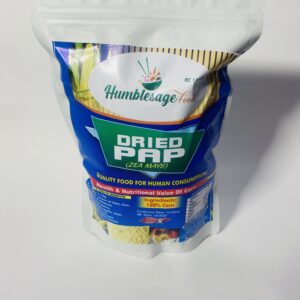Chili Pepper
Original price was: ₦3,000.00.₦2,000.00Current price is: ₦2,000.00.
Chili pepper, from the Capsicum genus, is a versatile ingredient known for its heat and diverse uses. Varieties like jalapeños, habaneros, and bell peppers add different levels of spiciness and flavor to dishes. Rich in vitamins A and C, capsaicin in chili peppers offers health benefits such as anti-inflammatory properties, metabolism boosting, and pain relief. Used in salsas, sauces, and stews, they enhance culinary traditions worldwide. Store fresh peppers in the refrigerator and dried ones in an airtight container for best shelf life. Enjoy the vibrant flavors and health benefits of chili peppers in your cooking!
Description
Chili pepper refers to the fruit of plants from the genus Capsicum, which are members of the nightshade family, Solanaceae. Chilli peppers are widely used around the world for their pungent flavor, heat, and diverse culinary applications. They come in various shapes, sizes, colors, and heat levels.
Botanical Description
- Scientific Name: Capsicum spp. (common species include Capsicum annuum, Capsicum frutescens, Capsicum chinense, Capsicum baccatum, and Capsicum pubescens)
- Family: Solanaceae
- Plant Description:
- Type: Perennial or annual herbaceous plants.
- Height: Ranges from 0.5 to 1.5 meters.
- Leaves: Ovate to lanceolate, smooth-edged, and medium green.
- Flowers: Small, white or purple, with five petals.
- Fruit: Varies greatly in shape, size, and color. Colors include green, red, yellow, orange, and purple.
Varieties of Chili Peppers
- Bell Peppers (Capsicum annuum): Mild, large, and bell-shaped; used as vegetables.
- Jalapeños (Capsicum annuum): Medium-sized, moderately hot, and green to red in color.
- Habaneros (Capsicum chinense): Small, very hot, and typically orange or red.
- Cayenne (Capsicum annuum): Long, thin, and very hot; usually dried and ground.
- Scotch Bonnet (Capsicum chinense): Similar in heat to habaneros, typically red or yellow.
- Bird’s Eye (Capsicum frutescens): Small, very hot, and typically red or green.
- Poblano (Capsicum annuum): Mild to medium heat, large, and typically green; becomes ancho when dried.
Physical Characteristics
- Size: Can range from a few centimeters to over 15 centimeters in length.
- Shape: Varieties include elongated, conical, bell-shaped, or round.
- Color: Green, red, yellow, orange, purple, or black, depending on the variety and ripeness.
- Texture: Smooth, glossy skin when fresh; becomes wrinkled and brittle when dried.
- Aroma and Flavor: Varies widely; can be sweet, smoky, earthy, or fruity, with heat levels from mild to extremely hot.
Nutritional Profile (per 100 grams of fresh chilli peppers)
- Calories: Approximately 40 kcal
- Carbohydrates: Around 9 grams
- Protein: About 1.9 grams
- Fat: Less than 1 gram
- Fiber: Approximately 1.5 grams
- Vitamins and Minerals: Rich in vitamin C, vitamin A, vitamin B6, potassium, and folate. Contains capsaicin, the compound responsible for their heat.
Health Benefits
- Rich in Antioxidants: High in vitamins A and C, which have antioxidant properties.
- Anti-inflammatory Properties: Capsaicin is known for its anti-inflammatory effects.
- Pain Relief: Capsaicin is used in topical creams for pain relief.
- Boosts Metabolism: Capsaicin can increase metabolism and aid in weight loss.
- Supports Heart Health: May help lower blood pressure and improve circulation.
- Immune System Support: High vitamin C content boosts immune function.
- Digestive Health: Promotes digestion and has antibacterial properties.
Culinary Uses
- Spice and Seasoning: Fresh, dried, or powdered chilli peppers are used to add heat and flavor to dishes.
- Sauces and Condiments: Essential in hot sauces, salsas, and chutneys.
- Pickling: Often pickled and used as a condiment.
- Infusions: Used to infuse oils and vinegars for added flavor.
- Smoked and Dried: Dried and smoked peppers, such as chipotle (smoked jalapeños), are used for their unique smoky flavor.
Traditional Recipes Using Chili Peppers
- Hot Sauce:
- Ingredients: Fresh chillies, vinegar, garlic, salt, sugar.
- Preparation: Blend all ingredients until smooth, then simmer and bottle.
- Salsa:
- Ingredients: Fresh tomatoes, onions, chilli peppers, cilantro, lime juice, salt.
- Preparation: Finely chop all ingredients and mix well.
- Chilli con Carne:
- Ingredients: Ground beef, tomatoes, beans, onions, garlic, chilli peppers, cumin, and other spices.
- Preparation: Cook beef with onions and garlic, add spices and chillies, then tomatoes and beans, and simmer.
Processing of Chili Peppers
- Harvesting: Chilli peppers are harvested when they reach the desired ripeness.
- Cleaning: Washed to remove dirt and debris.
- Drying: Can be sun-dried, oven-dried, or dried using dehydrators.
- Grinding: Dried chillies can be ground into powder.
- Packaging: Dried and ground chillies are packed in airtight containers to maintain freshness.
Storage
- Fresh Peppers: Store in the refrigerator for up to a week.
- Dried Peppers: Store in an airtight container in a cool, dark place for up to a year.
- Ground Pepper: Store in an airtight container in a cool, dark place for several months.
Cultural and Historical Significance
- Culinary Tradition: Integral to the cuisines of many cultures, including Mexican, Indian, Thai, and Chinese.
- Medicinal Uses: Used in traditional medicine for their healing properties.
- Economic Importance: A major cash crop in many countries, providing livelihood for millions of farmers.
Safety and Precautions
- Handling: Use gloves when handling hot peppers to avoid skin irritation. Wash hands thoroughly after handling.
- Consumption: Excessive consumption of very hot peppers can cause digestive discomfort.
- Allergies: Rare, but some individuals may be allergic to capsaic
Additional information
| Weight | N/A |
|---|---|
| Package Size | 100g |






Reviews
There are no reviews yet.